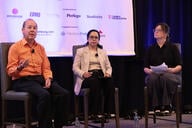You have /5 articles left.
Sign up for a free account or log in.

Istockphoto.com/EmirMemedovski
It's not hard to see that the nature of teaching in higher education is constantly changing, and the variety of teaching approaches continues to expand.
But teaching online, or incorporating open educational resources into classrooms, isn't always an intuitive skill, especially if instructors have grown accustomed over years or decades to more traditional teaching. Even instructors embracing technology-enabled teaching and learning can always benefit from more training.
There's no single template for professional development that can be applied at every institution or in every context. But seeing the breadth of professional development approaches might inspire solutions or plant seeds for ideas that will bloom later.
"Inside Digital Learning" examined three professional development programs: two for online instructors and one for incorporating OER into the classroom. Here's how they developed their models, and what they've learned in the process.
Go Big
Michelle Pacansky-Brock, faculty mentor for digital innovation at the California Community Colleges’ California Virtual Campus - Online Education Initiative (CVC-OEI), is part of a team that offers professional development around creating high-quality online courses to instructors at California’s 114 community colleges. CVC-OEI is distinct from the state's new online community college set to launch this fall.
Her office had been leading periodic one-off webinars that weren’t getting much traction.
More than 70 percent of the system’s faculty members are part-time, which means many of them don’t work regularly on campus, according to Pacansky-Brock. Hoping to generate more interest in professional development, Pacansky-Brock and her colleagues came up with an alternative model: instead of simply offering individual short courses, why not one big conference twice a year as well?
Each event, still entirely online and free, lasts a full day. Registration is open to participants outside the California system, though marketing is focused on community college instructors there. Last October’s gathering was centered around helping instructors use Canvas, the system’s designated learning management system; it drew more than 1,100 participants, Pacansky-Brock said.
“We really are trying to design these to be equitable professional development for anyone that can attend no matter where they are,” Pacansky-Brock said.
Each of the system’s colleges offers instructors their own professional development. The professional development team, which includes instructional designers, is tasked with making connections and facilitating sharing between institutions.
“What we see at the state level is that oftentimes … we have colleges up and down the state who are all grappling with the same problems, but they don’t reach out to the college just a couple miles away and say, ‘How are you solving this?’” Pacansky-Brock said.
The conference takes place via Zoom’s webinar feature, which includes Q&A and chat functions. Every speaker at the event participates in a practice session to navigate through technical glitches. Pacansky-Brock’s office discourages presenters from relying on slides.
“If our focus is on Canvas, we want folks to share Canvas,” Pacansky-Brock said. “Take us inside your course and show us.”
Do More With Less
Instructional designers at Florida Gulf Coast University have for several years offered a Blended Learning Academy for instructors looking to incorporate online elements into their teaching. Last spring, one faculty member suggested that the designers put together a separate training course for fully online instructors.
The university’s budget for professional development is too tight to compel or incentivize instructors to participate, according to David Jaeger, director of instructional technology services and elearning. Designers had to figure out how to do more with less.
The result was the Online Learning Academy, which consists of two full-day and two half-day sessions, taught by two instructional designers who work in the university’s elearning department. Instructors are welcome to attend whether they’ve already taught online or they’re preparing to do so for the first time. Course work includes videos, activities, readings and discussions.
The program’s leaders attend each semester’s new faculty orientation and introduce themselves in an effort to make early connections. They also advertise the academy during a new faculty orientation seminar discussion of the learning management system.
“They feel like they’re coming into something low risk, high outcome for that,” said Diane Marks, an instructional designer who teaches the academy. “It’s going to make sense for them, and they know us well.”
A pilot version of the academy delivered more instruction online than face-to-face, but the team found that faculty members felt uncomfortable simultaneously learning how to be students and teachers online. Now the first three sessions are offered in a physical classroom, and the remaining session is offered in a synchronous online format.
The academy is offered three times per year -- once each in spring, summer and fall.
Instructors tend to need the most help early on with understanding how to accomplish social presence in an online environment, according to CJ Jordanek, a senior instructional designer who teaches in the academy.
“Some think that once a week is enough to be in there; some think that everyone should be in there every minute of the day,” Jordanek said.
Designers also encounter plenty of skepticism from faculty members who don’t believe online courses can be comparable to face-to-face. By the end, they’re usually on the way to being convinced otherwise, Jordanek said.
“Our goals for the academy aren’t [that instructors are] really going to come out and be done,” he said. “All we’re looking to do is to crack the door.”
The elearning team eventually hopes to add a second, more advanced course, and to collect the university’s professional development courses into a certification sequence.
Heed Faculty Confusion
Faculty members in the State University of New York system who want to transition from proprietary course materials to open educational resources can take advantage of the OER faculty fellowship, a semester-long series of seminars and workshops that culminates in the creation of a new openly licensed course resource. The program originated in 2014 and has grown since New York state's substantial investments in OER.
According to Cailean Cooney, associate professor of open educational resources at the New York City College of Technology, the course was initially offered as a primer on OER and copyright licensing issues. “We found that the organization and information architecture of the course didn’t come natural to most of the faculty participating,” Cooney said. The program now leads instructors to shape course websites around OER materials.
First, instructors have to decide on an overarching structure for their site -- where navigation menus sit, how many items ought to be included. This first step can be “overwhelming” for faculty members, who might initially be tempted to overload the site, Cooney said.
After they’ve determined the structure, instructors get exposed to the “eccentricities of WordPress” and the importance of anticipating how students will interact with a site. The fellowship is designed to acquaint instructors with the concept of universal design for learning (UDL), which aims to ensure that all students, regardless of background or abilities, can access learning materials. The course doesn't explicitly mention UDL, but its themes come through in the material, Cooney said.
“Our faculty are generally very sensitive and aware of our student population, but they may just not have thought about checking out what the Open Lab looks like on their mobile device,” Cooney said.
Throughout the fellowship, faculty members critique existing materials while they work on their own.




